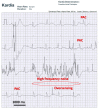Wearable Devices for Remote Monitoring of Heart Rate and Heart Rate Variability-What We Know and What Is Coming
- PMID: 36433498
- PMCID: PMC9695982
- DOI: 10.3390/s22228903
Wearable Devices for Remote Monitoring of Heart Rate and Heart Rate Variability-What We Know and What Is Coming
Abstract
Heart rate at rest and exercise may predict cardiovascular risk. Heart rate variability is a measure of variation in time between each heartbeat, representing the balance between the parasympathetic and sympathetic nervous system and may predict adverse cardiovascular events. With advances in technology and increasing commercial interest, the scope of remote monitoring health systems has expanded. In this review, we discuss the concepts behind cardiac signal generation and recording, wearable devices, pros and cons focusing on accuracy, ease of application of commercial and medical grade diagnostic devices, which showed promising results in terms of reliability and value. Incorporation of artificial intelligence and cloud based remote monitoring have been evolving to facilitate timely data processing, improve patient convenience and ensure data security.
Keywords: cardiovascular risk; heart rate; heart rate variability; remote monitoring.
Conflict of interest statement
The authors declare no conflict of interest.
Figures









Similar articles
-
Heart Rate Variability Measurement through a Smart Wearable Device: Another Breakthrough for Personal Health Monitoring?Int J Environ Res Public Health. 2023 Dec 6;20(24):7146. doi: 10.3390/ijerph20247146. Int J Environ Res Public Health. 2023. PMID: 38131698 Free PMC article. Review.
-
IoT-Based Heartbeat Rate-Monitoring Device Powered by Harvested Kinetic Energy.Sensors (Basel). 2024 Jun 29;24(13):4249. doi: 10.3390/s24134249. Sensors (Basel). 2024. PMID: 39001027 Free PMC article.
-
Wearable Systems for Home Monitoring Healthcare: The Photoplethysmography Success Pros and Cons.Biosensors (Basel). 2022 Oct 12;12(10):861. doi: 10.3390/bios12100861. Biosensors (Basel). 2022. PMID: 36290998 Free PMC article.
-
The Emerging Role of Wearable Technologies in Detection of Arrhythmia.Can J Cardiol. 2018 Aug;34(8):1083-1087. doi: 10.1016/j.cjca.2018.05.003. Epub 2018 May 9. Can J Cardiol. 2018. PMID: 30049358 Review.
-
Wearable Devices Suitable for Monitoring Twenty Four Hour Heart Rate Variability in Military Populations.Sensors (Basel). 2021 Feb 4;21(4):1061. doi: 10.3390/s21041061. Sensors (Basel). 2021. PMID: 33557190 Free PMC article. Review.
Cited by
-
ECG-Free Heartbeat Detection in Seismocardiography and Gyrocardiography Signals Provides Acceptable Heart Rate Variability Indices in Healthy and Pathological Subjects.Sensors (Basel). 2023 Sep 27;23(19):8114. doi: 10.3390/s23198114. Sensors (Basel). 2023. PMID: 37836942 Free PMC article.
-
A Comprehensive Review on Advancements in Wearable Technologies: Revolutionizing Cardiovascular Medicine.Cureus. 2024 May 29;16(5):e61312. doi: 10.7759/cureus.61312. eCollection 2024 May. Cureus. 2024. PMID: 38947726 Free PMC article. Review.
-
Cardiac arrhythmia and hypoglycaemia in patients receiving haemodialysis with and without diabetes (the CADDY study): protocol for a Danish multicentre cohort study.BMJ Open. 2023 Oct 27;13(10):e077063. doi: 10.1136/bmjopen-2023-077063. BMJ Open. 2023. PMID: 37890966 Free PMC article.
-
Endurance Sports and Atrial Fibrillation: A Puzzling Conundrum.J Clin Med. 2024 Dec 17;13(24):7691. doi: 10.3390/jcm13247691. J Clin Med. 2024. PMID: 39768614 Free PMC article. Review.
-
Challenges and standardisation strategies for sensor-based data collection for digital phenotyping.Commun Med (Lond). 2025 Aug 19;5(1):360. doi: 10.1038/s43856-025-01013-3. Commun Med (Lond). 2025. PMID: 40830260 Free PMC article. Review.
References
-
- Bayoumy K., Gaber M., Elshafeey A., Mhaimeed O., Dineen E.H., Marvel F.A., Martin S.S., Muse E.D., Turakhia M.P., Tarakji K.G., et al. Smart Wearable Devices in Cardiovascular Care: Where We Are and How to Move Forward. Nat. Rev. Cardiol. 2021;18:581–599. doi: 10.1038/s41569-021-00522-7. - DOI - PMC - PubMed
-
- Soon S., Svavarsdottir H., Downey C., Jayne D.G. Wearable Devices for Remote Vital Signs Monitoring in the Outpatient Setting: An Overview of the Field. BMJ Innov. 2020;6:55–71. doi: 10.1136/bmjinnov-2019-000354. - DOI
-
- Singh N., Moneghetti K.J., Christle J.W., Hadley D., Plews D., Froelicher V. Heart Rate Variability: An Old Metric with New Meaning in the Era of Using MHealth Technologies for Health and Exercise Training Guidance. Part One: Physiology and Methods. Arrhythm. Electrophysiol. Rev. 2018;7:193–198. doi: 10.15420/aer.2018.27.2. - DOI - PMC - PubMed
Publication types
MeSH terms
LinkOut - more resources
Full Text Sources
Miscellaneous

